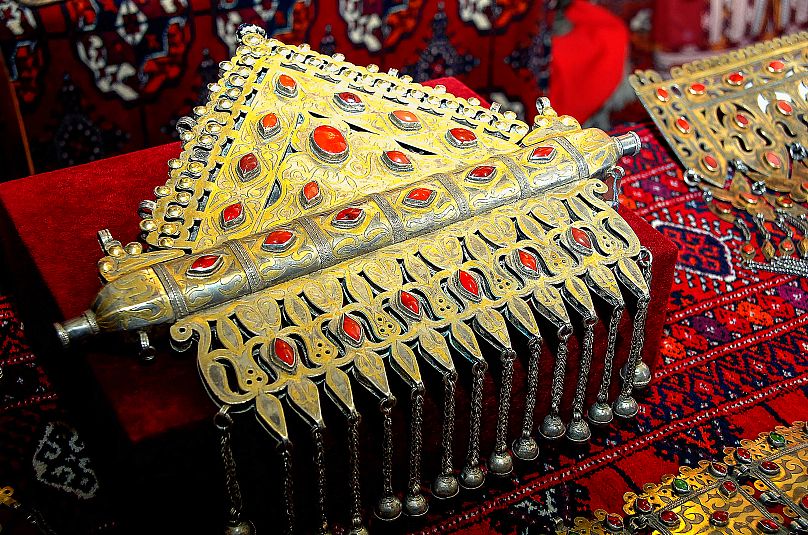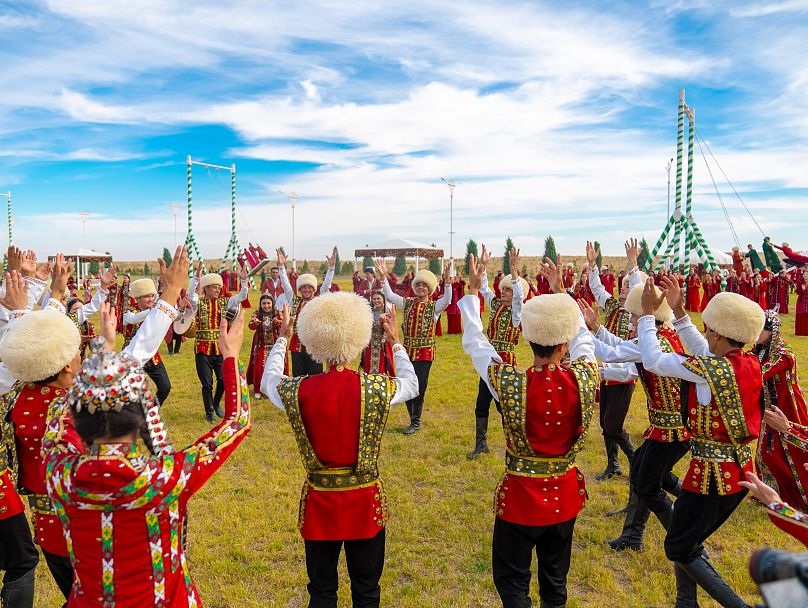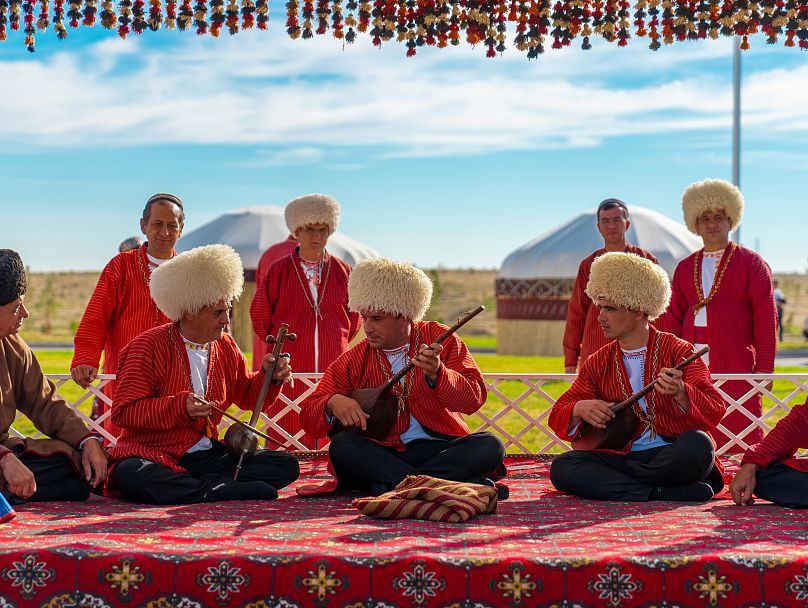Nestled in the heart of Central Asia, Turkmenistan boasts a cultural heritage as diverse and vibrant as its landscapes. Shaped by centuries of history and the influences of the Silk Road, Turkmenistan has preserved a tapestry of traditions that define its identity. From the ancient cities along the Silk Road to the vast deserts, Turkmenistan's cultural heritage is a testament to a rich tapestry of customs, craftsmanship, and celebrations.
The art of Gulyaka
The word "gulyaka" translates to "flower for the collar," aptly capturing the delicate beauty and floral motifs that characterize these exquisite Turkmen ornaments. Over time, however, gulyaka evolved into elaborate brooches and breastplates, gaining widespread popularity among Turkmen women.
Gulayka are not mere decoration, they hold profound cultural significance. These exquisite brooches continue to be crafted and worn as a reminder of the enduring legacy of Turkmen craftsmanship and cultural identity. Their intricate designs, often featuring symbols of nature, animals, and geometric patterns, reflect the Turkmen's deep connection to their environment and spiritual beliefs. The Gulyaka is often decorated with semi-precious stones, such as carnelian, turquoise, and emerald.
While traditional gulyaka were once crafted by skilled artisans using age-old techniques, the art form continues to thrive in modern Turkmenistan. Contemporary jewellers embrace traditional designs while incorporating modern elements, preserving the essence of gulyaka while adapting them to contemporary tastes. This fusion of tradition and innovation ensures that the art of gulyaka remains an integral part of Turkmen culture, and generates appeal amongst both local and international audiences.
Wedding jewellery
In Turkmenistan, the significance of jewellery in traditional weddings extends beyond mere adornment. It plays a vital and symbolic role in the celebration of love and union. Each piece of jewellery tells a story, weaving together the rich cultural tapestry of the Turkmen people.
Specific pieces of jewellery in Turkmen weddings are carefully chosen for their symbolic meaning. For instance, the intricate designs of bracelets, necklaces, and earrings often symbolize prosperity and good fortune for the newlyweds. The use of specific gemstones often carries additional meanings, representing aspects such as purity, strength, and enduring love. The bride's jewellery, in particular, is chosen with meticulous attention to detail, reflecting not only aesthetic preferences but also the cultural values and aspirations of the couple and their families.
The act of gifting and wearing these pieces during the wedding ceremony is a symbolic gesture, affirming the union and creating a lasting connection between the couple. The careful selection and exchange of jewellery is an expression of the couple's journey together, their families' blessings, and the cultural heritage that binds them.
The elegance of national attire
Turkmen weddings are not only a moment for the bride and groom to adorn themselves in stunning attire. Traditional Turkmen costumes have profound significance for the wedding guests as well. Their intricately designed and vibrant outfits play a pivotal role in the celebration, transforming the wedding into a vivid display of cultural pride.
Each costume reflects regional variations and historical influences, serving as a visual narrative of Turkmenistan's diverse heritage. The continuity of these costumes across generations preserves an enduring connection to cultural roots and traditions.
Kushtdepdi- The dance of youth and beauty
Kushtdepdi, a lively dance form deeply embedded in Turkmen culture, is a celebration of youth and energy that brings vibrancy to various festivities. This dynamic dance is characterised by fast and energetic movements, creating an atmosphere of joy and exuberance that resonates with participants and onlookers alike.
One of the remarkable aspects of Kushtdepdi is its inclusivity, transcending generational boundaries. While inherently associated with the vigour of youth, the dance is enjoyed by people of all ages. It serves as a unifying force, bringing together the young and the old in a shared expression of cultural celebration. The intergenerational participation in Kushtdepdi reinforces its role as a communal activity, fostering a sense of connection and continuity within Turkmen communities.
Kushtdepdi is not only a physical expression but a multisensory experience that incorporates traditional songs known as Ghazal and the rhythmic tones of the Gopuz, a lamellophone instrument. The dance is intricately connected to these musical elements, creating a harmonious fusion of movement and sound.
The traditional songs, Ghazal, provide a melodic backdrop to the dance, while the rhythmic tones of the Gopuz add a layer of intensity, creating a trance-inducing quality that further raises the energy of Kushtdepdi.
The Dutar
The Dutar, a traditional two-stringed instrument at the heart of Turkmenistan's cultural identity, plays a crucial role in preserving stories and traditions. Its presence in both traditional and contemporary musical compositions underscores its adaptability and enduring relevance.
Through its evocative tones, the Dutar is played to convey tales of love, valour, and historical events, ensuring that the oral traditions of Turkmenistan remain alive and vibrant.
The Dutar is often played at important cultural events, including weddings, celebrations, and gatherings, providing a living repository of the collective memories and folklore of the Turkmen people. Its role in passing down these stories is not only a musical performance but a continuation of the cultural legacy that defines the identity of Turkmenistan.
Preserving traditions for generations to come
UNESCO has recognised many Turkmen traditions as an Intangible Cultural Heritage of Humanity. This designation, granted to practices that embody the intangible aspects of a culture, underscores the significance and universal importance of Turkmen traditions on the global stage.
By earning the title of Intangible Cultural Heritage of Humanity, Turkmen traditions are recognised as having universal value. The practices are deemed integral not only to the local identity but also as part of the shared human cultural heritage, emphasising the importance of safeguarding and celebrating cultural diversity worldwide.
The enduring nature of Turkmen traditions is deeply rooted in the cultural fabric of the nation, reflecting a commitment to preserving and passing down these practices through generations. These traditions, whether in the realm of craftsmanship, music, dance, or attire, have withstood the test of time, maintaining their relevance and significance in Turkmenistan's contemporary landscape. The continuity of these traditions is a conscious effort by Turkmen communities to ensure that their cultural heritage remains vibrant and integral to their way of life.
Efforts are made to integrate traditional customs into modern contexts, ensuring that they remain relevant and accessible to younger generations. Cultural education initiatives, community events, and familial teachings contribute to the ongoing preservation of these practices, and elders play a pivotal role in passing down knowledge, emphasizing the significance of each tradition and its role in shaping Turkmen identity.
As Turkmenistan continues to honour its cultural legacy, it extends an open invitation to travellers from around the world. To witness the delicate beauty of Gulyaka, understand the symbolism in wedding jewellery, marvel at the vibrant elegance of national attire, and join in the jubilant celebrations of Kushtdepdi. These are experiences that offer visitors profound insight into the rich cultural tapestry of Turkmenistan.




